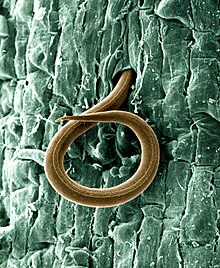Meloidogyne incognita
Meloidogyne incognita
Jump to navigation
Jump to search
Meloidogyne incognita | |
|---|---|
 | |
Scientific classification | |
| Kingdom: | Animalia |
| Phylum: | Nematoda |
| Class: | Secernentea |
| Order: | Tylenchida |
| Family: | Heteroderidae |
| Genus: | Meloidogyne |
| Species: | M. incognita |
Binomial name | |
Meloidogyne incognita | |
Meloidogyne incognita is a species of nematodes (roundworms) in the family Heteroderidae. It is commonly called the "southern root-knot nematode" or the "cotton root-knot nematode". This parasitic roundworm has worldwide distribution and numerous hosts. It is an important plant parasite classified in parasitology as a root-knot nematode, as it prefers to attack the root of its host plant.
When M. incognita attacks the roots of plants, it sets up a feeding location, where it deforms, (destroys) the normal root cells and establishes giant cells. The roots become gnarled or nodulated (knobbly, rough, and twisted), forming galls, hence the term "root-knot" nematode.
M. incognita has been found to be able to move along shallower temperature gradients (0.001C/cm) than any other known organism,[1] an example of thermotaxis. The response is complicated and thought to allow the nematodes to move toward an appropriate level in soil,[2] while they search for chemical cues that can guide them to specific roots.[3][4][5]
The life cycle has four juvenile stages and four moults (shed, cast).
See also[edit]
- Coffee root-knot nematode
Sodium azide - used for agricultural control of Meloidogyne incognita
References[edit]
^ Pline, Diez, and Dusenbery, J. Nematology, 20:605-608 (1988). Extremely sensitive thermotaxis of the nematode Meloidogyne incognita.
^ Dusenbery, D.B. Biological Cybernetics, 60:431-437 (1989). A simple animal can use a complex stimulus pattern to find a location,
^ Pline and Dusenbery. 1987. Responses of the plant-parasitic nematode Meloidogyne incognita to carbon dioxide determined by video camera-computer tracking. J. Chem. Ecol. 13 : 873-888.
^ Dusenbery. 1987. Theoretical range over which bacteria and nematodes locate plant roots using carbon dioxide. J. Chem. Ecol. 13 : 1617-1624.
^ Diez and Dusenbery. 1989. Repellent of root-knot nematodes from exudate of host roots. J. Chem. Ecol. 15:2445-2455.
- Lamberti, Franco and Taylor, Charles Edwin (eds.) (1979) Root-knot nematodes (Meloidogyne species): systematics, biology and control Academic Press, New York, .mw-parser-output cite.citation{font-style:inherit}.mw-parser-output .citation q{quotes:"""""""'""'"}.mw-parser-output .citation .cs1-lock-free a{background:url("//upload.wikimedia.org/wikipedia/commons/thumb/6/65/Lock-green.svg/9px-Lock-green.svg.png")no-repeat;background-position:right .1em center}.mw-parser-output .citation .cs1-lock-limited a,.mw-parser-output .citation .cs1-lock-registration a{background:url("//upload.wikimedia.org/wikipedia/commons/thumb/d/d6/Lock-gray-alt-2.svg/9px-Lock-gray-alt-2.svg.png")no-repeat;background-position:right .1em center}.mw-parser-output .citation .cs1-lock-subscription a{background:url("//upload.wikimedia.org/wikipedia/commons/thumb/a/aa/Lock-red-alt-2.svg/9px-Lock-red-alt-2.svg.png")no-repeat;background-position:right .1em center}.mw-parser-output .cs1-subscription,.mw-parser-output .cs1-registration{color:#555}.mw-parser-output .cs1-subscription span,.mw-parser-output .cs1-registration span{border-bottom:1px dotted;cursor:help}.mw-parser-output .cs1-ws-icon a{background:url("//upload.wikimedia.org/wikipedia/commons/thumb/4/4c/Wikisource-logo.svg/12px-Wikisource-logo.svg.png")no-repeat;background-position:right .1em center}.mw-parser-output code.cs1-code{color:inherit;background:inherit;border:inherit;padding:inherit}.mw-parser-output .cs1-hidden-error{display:none;font-size:100%}.mw-parser-output .cs1-visible-error{font-size:100%}.mw-parser-output .cs1-maint{display:none;color:#33aa33;margin-left:0.3em}.mw-parser-output .cs1-subscription,.mw-parser-output .cs1-registration,.mw-parser-output .cs1-format{font-size:95%}.mw-parser-output .cs1-kern-left,.mw-parser-output .cs1-kern-wl-left{padding-left:0.2em}.mw-parser-output .cs1-kern-right,.mw-parser-output .cs1-kern-wl-right{padding-right:0.2em}
ISBN 0-12-434850-5 ; - Diez, J. A., and Dusenbery, D. B. (1989) "Preferred temperature of Meloidogyne incognita" Journal of Nematology 21: pp. 99–104;
McCarter, James P. et al. (2003) "Analysis and functional classification of transcripts from the nematode Meloidogyne incognita" Genome Biology 4: R26, doi:10.1186/gb-2003-4-4-r26
External links[edit]
- Photo
- Description
Categories:
- Agricultural pest nematodes
- Grape pest nematodes
- Cotton diseases
- Tylenchida
(window.RLQ=window.RLQ||).push(function(){mw.config.set({"wgPageParseReport":{"limitreport":{"cputime":"0.372","walltime":"0.476","ppvisitednodes":{"value":3638,"limit":1000000},"ppgeneratednodes":{"value":0,"limit":1500000},"postexpandincludesize":{"value":16493,"limit":2097152},"templateargumentsize":{"value":2659,"limit":2097152},"expansiondepth":{"value":24,"limit":40},"expensivefunctioncount":{"value":13,"limit":500},"unstrip-depth":{"value":0,"limit":20},"unstrip-size":{"value":3788,"limit":5000000},"entityaccesscount":{"value":14,"limit":400},"timingprofile":["100.00% 443.579 1 -total"," 37.87% 167.994 1 Template:Taxobox"," 34.37% 152.458 1 Template:Taxobox/core"," 32.93% 146.052 1 Template:Taxonbar"," 18.39% 81.596 14 Template:Taxobox_colour"," 16.77% 74.370 1 Template:ISBN"," 15.57% 69.076 14 Template:Delink"," 14.28% 63.335 7 Template:Taxonomy"," 9.82% 43.568 1 Template:Catalog_lookup_link"," 9.74% 43.205 1 Template:If_empty"]},"scribunto":{"limitreport-timeusage":{"value":"0.174","limit":"10.000"},"limitreport-memusage":{"value":3161845,"limit":52428800}},"cachereport":{"origin":"mw1331","timestamp":"20190126163449","ttl":2073600,"transientcontent":false}}});mw.config.set({"wgBackendResponseTime":588,"wgHostname":"mw1331"});});

